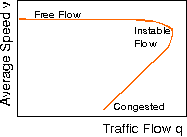
 |
JPL's Wireless Communication Reference WebsiteChapter: Network Concepts and Standards
|

It is generally accepted that the contribution of ATMS and ATIS to an optimal utilization of the available road infrastructure will be relatively small under normal conditions, but is presumed to be considerable in the case of deviant traffic conditions. For this reason, we distinguish another macroscopic traffic parameter that is of vital importance for both ATIS and ATMS and that can be derived from the three elementary traffic flow parameters: the prevailing traffic flow regime, i.e. free flow or congested traffic.
This parameter depends on the actual values of the three elementary parameters. Their coherence can best be explained by means of the well-known reciprocal relation that exist between the three elementary traffic parameters, namely q = v k. Based on this relationship the three so-called fundamental diagrams can be formulated, which outline the behaviour of the traffic flow, expressed in the elementary parameters q, v and k. Although various, dissimilar theories exist about the exact shape of the fundamental diagrams, their general outline is commonly considered to be appropriate. The Figure illustrates one possible and rather simplified appearance of one the fundamental diagrams, viz. the speed-flow (vq) diagram based on the linear speed-density model of Greenshields. In this speed-flow (vq) diagram, we can observe two distinct states of the macroscopic traffic flow. In the commencement of the first state, that of free-flow traffic, the individual vehicles that constitute the traffic flow hardly impede one another and the prevailing speed v remains well above the theoretically optimum speed vo. As the number of vehicles in the traffic flow increases, the vehicles more and more suffer from one another and the speed decreases and eventually approaches vo. In the second state, that of congested traffic, the individual vehicles impede each other in such a way that both the flow and the speed further decrease.
Besides the four depicted elementary traffic flow parameters, also other characteristics of the actual traffic flows on the road network(s), might be of interest for ATMS or ATIS. Examples of such additional relevant traffic flow parameters would be the actual capacity and origin- destination data.
The other elementary macroscopic traffic flow parameters that we have distinguished, viz. the density k and the flow q, might, in some subordinate way, contribute to the ATIS objectives, but are certainly not indispensable. Therefore, we will only suggestively address obtaining and further processing data concerning the actual value of the flow q and the density k.
Since swift detection of disturbances in the traffic flow and deploying measures accordingly, is crucial for ATMS, also selection of the prevailing traffic regime, i.e (automatic) detection of incidents, is of major importance for ATMS. Existing Automatic Incident Detection (AID) systems basically belong to the class of ATCS (i.e., they are local-oriented).